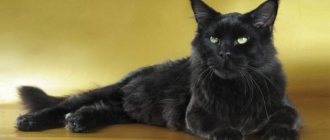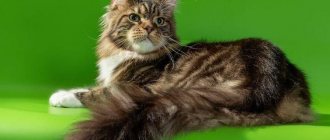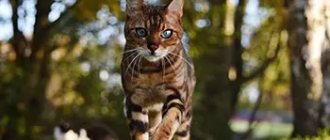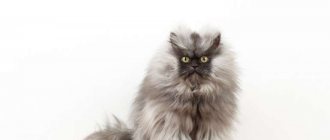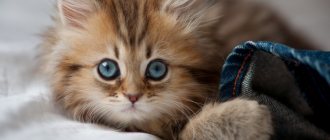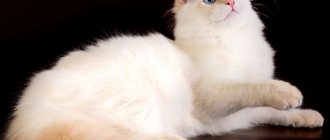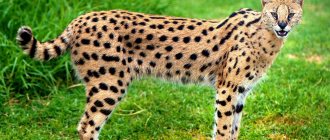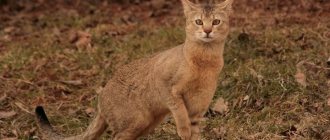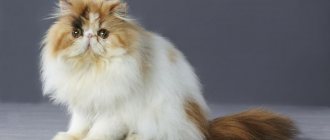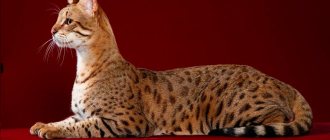Nature has endowed all cats with a difficult character, but black cats are also distinguished by their unusual appearance. People blame these animals for all misfortunes and superstitiously try not to cross them on the road.
Apparently, this is how the subconscious fear of the dizzying beauty of animals in shiny coal-colored coats is expressed. But this color in different combinations is found in almost all cat breeds.
Features of black cats
The pigment melanin is responsible for the formation of skin and coat color. There are two types of it: eumelanin and pheomelanin. Both pigments differ in structure.
The grains of the first have a spherical shape, due to which they absorb light and produce black pigment and all its derivatives - chocolate, lilac, blue, fawn. Pheomelanin grains reflect light in the red range and are responsible for this color and all its varieties.
Color is inherited depending on gender, since the gene is located on the X chromosome, it is not on the Y chromosome.
A male with one X chromosome can carry black or red. A female with two X chromosomes carries three color options (red, black, tortoiseshell).
The genes responsible for color are passed on to the son through the maternal line. A black cat cannot produce a red cat, and a red female will never produce a black male.
Character
Black cats have highly developed empathy; they feel the owner’s mood swings, his emotional and physical state. These purrs know how to amuse and heal.
Animals are tolerant of children's antics, are not prone to aggression, easily adapt to circumstances, and quickly recover from stress.
It is generally accepted that blackies are weather sensitive. By observing the behavior of their pets, owners learned to predict weather changes. There are cases when black cats warned their owners about the approaching earthquake. Showing concern, the animals forced people to leave their homes.
Advantages and disadvantages
Advantages:
- flexible disposition;
- responsiveness;
- peacefulness;
- attractive appearance;
- empathy.
Cats with black fur have no objective disadvantages.
Characteristic eye color
The genetics of the pupil is less studied than the properties of fur. Researchers suggest the presence of a color gene and some polygenes that are located outside the studied structures and affect the characteristic features of the organism.
Felinologists identify three most common combinations:
- Black cats with green (grn) eyes are a classic color combination.
- The second group is orange, brown and amber-honey (org) eyes.
- The final position is in the copper color range (cpr). Fairytale black cats with red eyes actually come from this category.
When recessive alleles (b, bl) come into play and various shades appear on the cat's coat, the pupil color combinations automatically dilate. But absolutely black cats have only the three listed eye colors.
This is interesting! Black coat color is never ideal. It all depends only on the degree of its saturation, which hides some natural pigmentation flaws.
Color options
According to international standards, the black color is assigned the code n (sil, wild, ebony, sable). The guard hairs and undercoat should have a uniform color: each hair is completely dyed, without colored or white inclusions.
The nose, paw pads, and whiskers must be exclusively black.
Possible eye colors
The iris of the eyes often plays with all shades of yellow and green: bright emerald, bright green, orange, olive, light sand.
Reference. Black kittens are born with blue irises.
Summarizing
Black cats have always attracted the attention of people; they were surrounded by an aura of mystery and even witchcraft. Superstitious people still believe that a black cat crossing the road brings bad luck. It has long been proven that this sign has no basis, so lovers of coal pets, free from prejudice, dote on them.
Despite the fact that such cats “get in the way” of their owners every day, this only brings them happiness
Bright green eyes are a real decoration of a black cat, because there are no other shades in its color. This spectacular combination is present in many breeds, and a person who wants to buy a black green-eyed kitten can be guided by his preferences in the pet’s character.
Top best black cat breeds
There are no exclusively black cat breeds in nature. These include perhaps a variety of Burmese cats - the Mandalay breed. This bright black beauty with piercing yellow eyes has not yet been recognized by international organizations, however, due to the growing popularity of the Burmese, we can expect their official recognition in the near future.
Black colors are found in the following breeds: Maine Coon, British and Scottish cats, American Curl, Bombay, Manx, Chausie, Cymric.
Persians and Egyptian Mau are characterized by smoky colors: the tips of the hairs are dark gray or black, and the base is light.
Bombay
The only cat breed whose standard allows only black color. Externally, the animals resemble a panther. The breed was developed in the USA in the 50s. XX century. The coat should be dark, without streaks or marks. The nose and paw pads are only black.
Kittens are born with blue eyes. As animals mature, the iris turns gray and then acquires a rich golden-amber hue.
Persian
The color variability of Persians is amazing. One of them is raven color, without red. The undercoat is slightly shorter, but the shade is the same. The coat is luxurious, long, iridescent. Paw pads and nose are black-brown or black. The skin has a gray-blue tint. The iris of the eyes is dark orange or deep copper.
The fur is thick and easily tangled, so it needs regular brushing. A lush collar adorns the neck, shoulders and chest.
Devon rex
A young breed of English origin. One of the color options is black with a gray or blue tint. At the same time, the coat is very short, soft, curly, without hard guard hairs. The eyes are slanting, expressive, of any color: golden, green, yellow, hazel, orange, olive.
The black color is also included in other colors: mackerel, silver-black, tabby, bicolor.
American Bobtail
Short-tailed cat of American origin. There are various shades of black: ash, charcoal, dark chocolate. The eyes are large, almond-shaped, hazel, green, and light yellow in color. The nose and paw pads are black or dark brown.
The American Bobtail is closely related to the Kurilian Bobtail. The breed received official recognition in 1989, although the breed characteristics were established in the 60s. gg. XX century. Representatives of the breed have strong bones and a powerful build. The character is flexible, which makes the “Americans” everyone’s favorites.
Norwegian forest
The Norwegian Forest Cat is a real beauty, the national pride of the United States, and has an external resemblance to the Siberian cat. There are numerous colors, but the most spectacular is black. The iris of the eyes can be green, amber, hazel, or golden.
The coat is thick, double, repels water well, the neck is decorated with a “collar”, and the hind limbs are decorated with “socks”.
A fur collar on the neck protects from severe frosts, and powerful paws help to move quickly. The Norwegian Forest loves freedom and is suitable as a companion for those who will not limit its actions.
Manx
Representatives of the breed are born with short tails or without them at all. The coat is two-layered, the black guard hair is lined with a dense dark-colored undercoat. The iris is colored in yellow and orange shades. The nose and paw pads are also black.
The dark color is variable: tabby (dark stripes on gray or fawn), smoky, dark chocolate, dark gray.
Maine Coon
The Maine Coon is a large cat with a long, smooth coat. The black color is deep and rich. The skin is gray or light with a blue tint. The paw and nose pads are deep black. The iris is copper or red.
Pure color is rare; often the fur coat has a dark striped, marbled, spotted pattern.
Maine Coons love to be the center of attention and interact with family members. Animals are extremely delicate, do not impose themselves, and do not get underfoot.
British
The British cat is better known by its blue color. The image of a gray plush murka appears in the head when the breed is mentioned. The animal's fur is thick and soft to the touch. The length of the undercoat coincides with the length of the guard hairs, the black tone looks velvety and deep.
The British have a yellow-orange iris. Available shades range from nut to bright orange. The nose and paw pads are black or a shade lighter.
Reference. The peculiarity of plush fur is its complete absorption of color.
Scottish
A distinctive feature of the Scottish Fold cat is its round head, flattened muzzle and drooping ears. The wool is fluffy, “cloudy”, very soft and pleasant to the touch. There are 1-3 folds on the ears. Black color is rare.
It is considered real luck to have a charming Scotsman with resinous fur. The irises of the eyes are the same as those of the British - the color varies from hazel to bright orange.
Siberian cat
The Siberian cat is large, fluffy, with massive bones. There are many color options, but black is the least common color. The dark color is rich and deep. The fur is dense, the undercoat is double. There is a frill on the chest, and pants on the hind legs. The tail is luxurious, anthracite in color, fluffy, like a broom. The iris is yellow with a light edging.
The density of the undercoat varies depending on the time of year: in spring and summer it is short, in winter and autumn it is fluffy and long.
The neck is framed by a lush “collar”, on the hind legs there are wide “pants”, the tail is pubescent in a plume type.
Oriental cat
Impressive, refined, graceful - this is how you can characterize the Oriental cat. The short fur is blue-black, the nose and paw pads are blue-black. The structure of the fur is soft, pleasant to the touch, and has a precious shimmer.
The dark color of the Oriental is called ebony, which translates as ebony. Against the background of such a luxurious coat color, the green iris of the eyes looks wonderful. In addition, Orientals also have yellow eyes. .
Sphinxes
When the body of the Canadian, Don, and St. Petersburg Sphynx produces euomelamamine in excess, the skin of cats becomes dark gray, or rather the color of wet asphalt.
Don Sphynx
Cymric
Cymrik is a good-natured creature with a fluffy coat. The guard hairs and undercoat are the same length. The dark color is closer to charcoal purple.
The cats are called little bears due to their thick fur, compact build, round muzzle and short tail.
Chausie
The Chausie is one of the largest hybrid breeds. Dark color - solid black and black grizzly (salt and pepper).
When breeding the breed, breeders used the Abyssinian cat and the jungle cat. The presentation of the chausie took place in 1990. These cats are endowed with natural grace and a peaceful disposition.
Bengal
The Bengal's coat is dense, short, and silky. The charcoal color of the Bengal is not yet included in the breed standard. Animals with such colors look gorgeous. Under sunlight or artificial lighting, dark spots and rosettes are visible on the shiny black fur.
Bengals are playful, inquisitive, affectionate and calm.
Scottish fold
Black Scottish Folds with shiny coats and copper eyes are perhaps the most beautiful of the breed.
This breed of black cat is striking with its small, curled ears and flattened nose. The appearance of their neat earless head with huge round eyes is reminiscent of a small owl.
The character of these cats is calm and lazy. Scottish Folds will not climb on tables or hang from curtains.
Scottish Folds are cats with developed intelligence. They are trainable and can learn various tricks. But they don’t know how to jump at high places at all - this is due to changes in the vestibular apparatus.
A Scottish Fold kitten costs from $100 to $3000.
Breeds of long-haired black cats
List of long-haired black cat breeds:
- Neva Masquerade;
- Siberian;
- Maine Coon;
- British Longhair;
- Persian;
- American Bobtail.
Shorthair
List of shorthaired breeds with dark coats:
- chausie;
- Bengali;
- oriental;
- Cymric;
- Manx;
- British Shorthair;
- Scottish lop-eared;
- Devon Rex;
- Bombay.
Bald
Hairless cat breeds are hairless, but such animals have dark skin. These are the Peterbald, Don and Canadian Sphynxes. In elves, Ukrainian Levkoy, Dwelf, Minskin, dark skin color is less common.
Devon Rex
This cat looks like a magical creature. The black color of the curly coat may consist of patterns interspersed with silver or ocher tints. Emerald or hazel eyes sparkle. It feels like their gaze penetrates into the depths of the soul. Low-set ears, a thin neck and long legs give their appearance a special magic.
Energetic cats have a good disposition. They like people and are ready to live with them in a city apartment.
Devon Rexes are very active. In addition, they are excellent at expressing emotions. To communicate with people, they have a rich vocabulary consisting of a variety of sounds.
If you are allergic to cats, get a Devon Rex. These cats are considered hypoallergenic, which gives many people a chance to find a pet.
An elf kitten will delight you for $200.
Nuances of care
Caring for cats depends on the length and thickness of the coat, the presence or absence of undercoat. A long, luxurious fur coat needs careful care. The purr with its undercoat must be combed regularly, especially in winter, when the fur grows intensively under the influence of heating devices. The same applies to periods of seasonal molting.
Hairless cats have nothing to comb; instead, owners should pay due attention to moisturizing the skin and removing sebum and sweat.
Breeders recommend accustoming animals to hygiene procedures from an early age, so that later bathing and brushing do not cause aggression.
Cats with thick undercoat are brushed with a furminator twice a week. The tool easily removes fluff, and animals do not perceive the procedure as an execution.
Persians are brushed with a slicker brush due to the special structure of their coat. The tool untangles but does not pull out airy cat fur.
It is not advisable to neglect the procedure for combing long-haired cats, because their hairs often become tangled, and the tangles then have to be cut off.
To maintain healthy coat and skin, veterinarians advise adding vitamin and mineral complexes to the diet.
Characteristic diseases
Representatives of aboriginal breeds (Siberian cat, Maine Coon, Neva Masquerade cat) have excellent health and rarely suffer from infectious diseases.
Breeds bred by breeders are prone to genetic diseases. For example, Scottish Fold cats suffer from cardiovascular diseases and have kidney problems.
Persians have difficulty breathing due to the incorrect structure of the nasal septum; diseases such as:
- retinal atrophy;
- viral rhinotracheitis;
- renal failure;
- hypertrophic cardiomyopathy.
Orientals suffer from gastrointestinal diseases, bronchial asthma, heart pathologies, retinal atrophy, and strabismus.
The Sphynx is often diagnosed with urticaria. And this is not surprising, because his delicate skin is very sensitive. The Don Sphynx is treated for acne, seasonal dermatitis, lichen and dermatophytosis, corneal ulcers, conjunctivitis and scleritis.
Signs about black cats
A black cat crossing the road is a harbinger of bad luck. This belief is actively circulating by word of mouth in the post-Soviet space, some European countries and the USA. But for a resident of Great Britain and Japan, this portends a good sign and unexpected joy. If you still believe in folk omens, if you meet a black cat on the road, spit three times over your left shoulder or grab a button.
The British believe that a black cat protects a person’s home from thieves, and also helps single women find their soulmate.
A cat sitting on the threshold needs to be let into the house and warmed up - in gratitude it will attract wealth and peace into the house. The animal cannot be driven away. In any case, such behavior characterizes a person from the bad side.
If a cat gives birth to red and black kittens, according to popular belief, it is better to place the red one in good hands, and leave the black one in the house for good luck.
If a black cat sneezed not far from the bride, it means the marriage will be happy.
In ancient times, black cats were kept in temples and were considered amulets.
This is interesting! In the Middle Ages they believed that a cat was an enchanted witch. Women who dared to have a black animal were burned at the stake.
The Chinese, on the contrary, warded off evil spirits with the help of cats.
Scandinavian fishermen took fluffy animals on boats, thereby insuring themselves against storms.
The Slavs were not afraid of pitch-black cats, but, on the contrary, attracted them to their homes. The mustaches quickly caught mice.
As you can see, there are not so few good omens. What to believe is the choice of each of you. The main thing is not to forget that animals should not suffer from prejudice, because kushki do not spread negative energy and do not wish harm to anyone.
Purchasing a black kitten
When a person decides on the breed of the desired pet, the question arises “where to go.” In every city there are many places for selling purebred (and not so purebred) kittens - from bird markets to elite nurseries. However, the future cat breeder must understand that the better and more expensive the conditions for keeping a kitten, the better the animal will be (healthier, more beautiful, more well-groomed). Although the metering issue may also play a role here. Kittens from professional breeders and nurseries are more expensive, so sometimes those who want to find a beautiful black cat look for simple advertisements on the Internet, newspapers, or turn to friends.
If it is difficult to find reliable information in the newspaper, then the Internet can definitely help you. At a minimum, you can read reviews about a particular breeder, find information about a specific cat, and if you’re lucky, photos of black kittens. As a maximum, you can contact a club that deals with the chosen breed. Club members, like no one else, know everything about the breed. They can recommend a breeder and even a specific kitten.
beautiful and healthy purebred kittens can be purchased from breeders
If you don’t need a kitten “right away,” then you can wait for the next exhibition. Sometimes purebred cats are exhibited in a separate class, you can “cheer” for them and then buy them. And sometimes the entire litter is exhibited at once. Here you can choose a kitten that suits you in all respects. By the way, you can also meet the kitten’s mother right there. If you find yourself a little black friend right at the exhibition, then this is an almost one hundred percent guarantee of its quality (purebred).
Main selection criteria
In order for a cat to grow into a beautiful domestic animal with a shiny coat, you need to choose the best kitten. Typically, future pets are selected based on several criteria:
- appearance of the animal;
- kitten behavior;
- availability of documents;
- age.
the chosen kitten must be beautiful and well-groomed
You need to pay attention to the appearance of the animal. Sometimes external features indicate the health of cats. A healthy kitten must meet the following characteristics:
- The teeth look clean and free of tartar, and there is no unpleasant odor from the mouth.
- A healthy kitten's gums are pink and show no signs of bleeding.
- The third eyelid (called the nictitating membrane) does not cover part of the eye.
- The kitten's skin looks clean and healthy, without irritation, dirt, scabs or flea excrement.
- The animal's coat is shiny and clean, without bald spots or tangles.
- He holds his head up normally and walks or runs with absolutely no limp.
- There is no liquid or other discharge from the eyes, nose or ears.
- The abdomen feels quite strong and at the same time not bloated.
- He doesn’t twitch his head, he doesn’t have a runny nose, a cough, or any other external painful signs.
You can examine the behavior of a kitten by holding it in your arms. A psychologically healthy kitten will readily be held and will try to play with human hands. No gesture of yours should scare the baby, he should not be aggressive. But your future chosen one should not be hyperactive, the cat should be moderately meek, playful and playful. You can also pay attention to the kitten’s face. The animal should not look gloomy or sad. His gaze should alternate between interest and drowsiness (after playing enough, kittens can fall asleep).
you need to choose an active and friendly kitten
If the purebred of the future pet is important, then the baby must have documents. The main document for a cat is a veterinary passport; information about all operations and vaccinations is entered there. There must also be a pedigree. ONLY its presence can confirm the purity of the cat’s parents. Sometimes a kitten is not suitable for further breeding, so when selling, the breeder strongly recommends spaying or neutering the animal. A professional breeder may not release the kitten's paperwork until you confirm that the surgery has been completed.
Suitable age of the pet
The age of the kitten is an important criterion when choosing an animal. Little kittens that have just learned to walk are incredibly charming, but you can’t just follow your own desires. During the first 1.5–2 months of life, the kitten is just learning to explore the world, so it is important that its mother is nearby. By tearing your baby away from the nurse at this age, you risk exposing the animal to stress. In the future, this can cause serious problems in raising a pet.
The critical period for the development of immunity in kittens occurs at 8–12 weeks. At this time, the antibodies obtained from the mother cat cease to act, and those obtained after artificial vaccination are just beginning to develop. This intermediate time is the most difficult. Often people do not attach importance to such little things, but a small kitten (up to 3 months) is especially susceptible to respiratory diseases and diarrhea.
It is not recommended to adopt a kitten under three months of age
The first vaccination of kittens includes vaccinations against calcivirus, rhinotracheitis and panleukopenia, but immunity after them does not appear immediately, but only after 10 days. For this reason, it is important to allow the baby to be close to the nurse. Even if the kitten is already switching to adult food, then with mother’s milk he will be able to receive at least a small dose of antibodies. There was a case in my family when we adopted a small kitten (he was 1–1.5 months old). The kitten was already eating on his own, so it was decided that he could handle it. The cat got sick because he was not vaccinated (at that time almost no vaccinations were given to domestic cats). The animal fell ill, but it was not possible to save it.
Some people are afraid to wait 3 months because they believe that an older animal will not be able to get used to new people. In fact, everything is different. It is the maturing cat that can adapt better. In adult animals, intelligence has already formed; the matured pet understands that new people have become his family, that it is they who feed and caress him. In addition, adult animals are more resistant to stress, and due to nervousness they do not experience the same health problems that can occur in a baby. Let the kitten stay longer with its mother - she will teach him everything she knows, then you will get the obedient, affectionate and moderately mischievous cat of your dreams.
